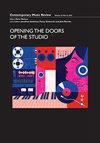何《Angst》中的踱步、表演与感知
IF 0.3
2区 艺术学
0 MUSIC
引用次数: 0
摘要
摘要本文通过对Angst(Ho,Alice Ping Ye.2000)的个案研究,探讨了演奏者在音乐节奏和表达时机方面的决定如何影响音乐作品中情感状态的交流。Angst。加拿大音乐中心),由Alice Ping Yee Ho作曲,女高音Janice Jackson首演。何将这部女高音独唱作品描述为“对女性自卑神话的反应”,“表达了女性遇到的恐惧和焦虑”。Angst包括波动的时间特征、持续时间不同的长音符,以及在不可预测的时间进入的反复出现的动机,当这些因素结合在一起时,可能会使听众辨别一致节拍和/或预测未来音乐事件的能力复杂化。通过对安格斯特的录像,我观察了杰克逊的表演如何传达出主人公表达的焦虑。我借鉴了达努塔·米尔卡的改编作品(米尔卡,达努塔,2009年)。《海顿和莫扎特的公制操作:弦乐室内乐》,1787-1791。牛津:牛津大学出版社)。《音乐解析与音乐情感》,音乐感知9(2):199-230),大卫·休伦的音乐期望理论(休伦,大卫,2006)。甜蜜的期待:音乐与期待心理学。马萨诸塞州剑桥:麻省理工学院出版社),以及Austin Patty的起搏场景(Patty,Austin T.2009)。《起搏场景:和谐节奏和旋律起搏如何影响我们的音乐高潮体验》,音乐理论谱31(2):325-367),我通过讨论起搏的情感影响来扩展这项工作。我认为,杰克逊对何的演奏创造了一种令人困惑的聆听体验,反映了作品的焦虑、恐惧和权力意识的主题。本文章由计算机程序翻译,如有差异,请以英文原文为准。
Pacing, Performance, and Perception in Alice Ping Yee Ho’s Angst
ABSTRACT This paper examines how performer decisions regarding musical pacing and expressive timing can shape the communication of affective states in a musical work, through a case study of Angst (Ho, Alice Ping Yee. 2000. Angst. Canadian Music Centre), composed by Alice Ping Yee Ho and premiered by soprano Janice Jackson. Described by Ho as a ‘reaction to the myth of the inferiority of women’, this work for solo soprano ‘express[es] the fear and anxiety that women encounter’. Angst includes fluctuating time signatures, long-held notes of varying durations, and recurring motives that enter at unpredictable times, which, when combined, can complicate a listener's ability to discern consistent metre and/or predict future musical events. Using a video recording of Angst, I examine how Jackson's performance conveys the anxiety expressed by the protagonist. I draw on Danuta Mirka's adaptation (Mirka, Danuta. 2009. Metric Manipulations in Haydn and Mozart: Chamber Music for Strings, 1787–1791. Oxford: Oxford University Press) of Ray Jackendoff's parallel multiple-analysis model for determining metre (Jackendoff, Ray. 1991. “Musical Parsing and Musical Affect.” Music Perception 9 (2): 199-230), David Huron's theory of musical expectation (Huron, David. 2006. Sweet Anticipation: Music and the Psychology of Expectation. Cambridge, MA: MIT Press), and Austin Patty's pacing scenarios (Patty, Austin T. 2009. “Pacing Scenarios: How Harmonic Rhythm and Melodic Pacing Influence Our Experience of Musical Climax.” Music Theory Spectrum 31 (2): 325-367), and I expand on this work by discussing the affective impact of pacing. I suggest that Jackson's performance of Ho's score creates a confounding listening experience that reflects the work's themes of anxiety, fear, and realisation of power.
求助全文
通过发布文献求助,成功后即可免费获取论文全文。
去求助
来源期刊

Contemporary Music Review
MUSIC-
CiteScore
1.00
自引率
25.00%
发文量
48
期刊介绍:
Contemporary Music Review provides a forum for musicians and musicologists to discuss recent musical currents in both breadth and depth. The main concern of the journal is the critical study of music today in all its aspects—its techniques of performance and composition, texts and contexts, aesthetics, technologies, and relationships with other disciplines and currents of thought. The journal may also serve as a vehicle to communicate documentary materials, interviews, and other items of interest to contemporary music scholars. All articles are subjected to rigorous peer review before publication. Proposals for themed issues are welcomed.
 求助内容:
求助内容: 应助结果提醒方式:
应助结果提醒方式:


